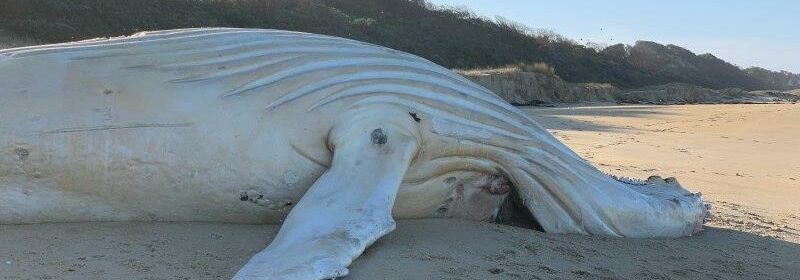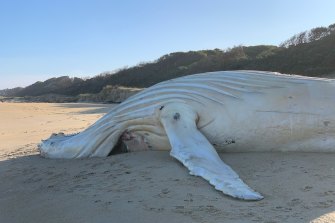Washed-up white whale is not Migaloo, experts confirm

Experts have confirmed the white humpback whale carcass that washed up on a remote beach on Victoria’s far-eastern coastline is not the famed albino whale, Migaloo.
Images shared by beachgoers on Saturday showed an intact whale carcass on a beach near Mallacoota. There were fears the whale could be Migaloo, which has not been seen in Australian waters for two years but whose migration patterns would align with washing up on the beach.
The humpback whale carcass that washed up near Mallacoota, eastern Victoria, this week.Credit:Tyler James
A spokesman from the Department of Environment, Land, Water and Planning (DELWP) said experts had confirmed the whale was not Migaloo and there would be further assessments of the carcass in the coming days.
“DELWP officers have examined images of the dead humpback whale at Mallacoota and have confirmed it is a sub-adult female. Migaloo is a male,” the spokesman said.
“I urge anyone in the area not to approach within 300 metres of the carcass.”
Officers will determine the colour of the whale. Dead humpback whales often lose their colour and appear white if they have been in the ocean for some time.
Whales are protected under Victoria’s Wildlife Act regardless of whether they are alive or dead, meaning it is an offence for members of the public to interfere with or take any parts of the whale.
People and animals must remain at least 300 metres away from beached whales at all times.
Migaloo, whose name means “white fella” in several Indigenous languages, is believed to have been born in 1986 and was first spotted in 1991 off the coast of Byron Bay. But the last sighting of Migaloo, aged in its mid-30s, was in June 2020.
Dr Kate Robb from the Marine Mammal Foundation said there were many signs in photographs and videos of the dead whale that suggested it was not Migaloo, including visible patches of black skin.
She noted an average adult humpback whale such as Migaloo measured 16 metres, while the one washed up near Mallacoota was only nine or 10 metres long.
“He’s an iconic whale, and he really has created a connection to the humpback whales, which is why everybody’s so passionate about him, which is fantastic,” she said.
“One of the most important things is the morphology of the genital area, that’s very indicative of it being a female. They have very different sorts of structures and layouts of that genital area.
“When whales die, their skin breaks down very quickly, and then it starts to slough off. But you can still get areas where that black skin is still attached.
“There’s a couple of locations below the pectoral fin and then around the barnacles where the throat plates are where we can still see some black skin, so that’s indicative of not being [albinism] or Migaloo.”
Robb said the dead whale remained a “very important animal” for researchers and tests would be done on why it washed up, and whether there are plastics in its stomach or high levels of toxins.
The Morning Edition newsletter is our guide to the day’s most important and interesting stories, analysis and insights. Sign up here.
Most Viewed in National
From our partners
Source: Read Full Article
